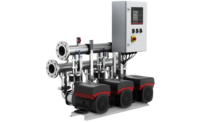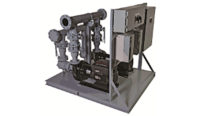Grundfos’s Distributed Pumping is a paradigm shift in hydronic system design, created to optimize the entire HVAC system while improving occupant comfort. It replaces energy-wasting balance and control valves in HVAC systems with intelligent, reliable, and maintenance-free pumps that generate pressure only when and where needed. Our panel of judges celebrated these achievements by naming Grundfos’s Distributed Pumping the 2022 Commercial Comfort Product of the Year in the Pumps & Flow Controls category.
Distributed Pumping is a hybrid pumping arrangement combining variable primary and variable secondary systems, which reduces pump energy between 50% and 80%, significantly improves delta-T, and provides a constantly auto-balanced HVAC system that improves occupant comfort.
“Distributed simply means the secondary pumps are distributed through the piping network to be located adjacent to each zone, specifically the air-handling unit or bank of fan-coil units,” said Chris Ireland, lead key account manager, CBS - USA & Canada, Grundfos. “These distributed pumps will be installed in place of control valves and balancing valves. A low-resistance check valve is added to the discharge side of each distributed pump, which will prevent backflow in the HVAC system. The primary pumps are only sized for the pressure losses through the bypass in the mechanical room and along with full system flow. This will drastically reduce the size of the pumps in cost, horsepower, and physical space compared to a primary/secondary pumping arrangements.”
Chilled water hydronic applications traditionally have been arranged in two ways — primary with variable secondary or variable primary pumps. In both types of systems, the heat transfer fluid is moved throughout the piping network by pumps and controlled by a series of balance and control valves. The pumps are located in the mechanical room, and most of the balance valves, and all of the control valves, are located throughout the network of chilled water piping. They are used to control flow to the zones.

A pressure independent control valve (PICV) is best described as three valves in one: a standard two-way control valve, a balancing valve, and an automatic differential pressure-regulating valve.
With Grundfos’s Distributed Pumping, the need for control and balancing valves at each zone is eliminated by adding smart, maintenance-free circulating pumps in their place.
“These distributed pumps are low horsepower and highly efficient ECMs [electronically commutated motors], which are not available in traditional higher horsepower motors,” said Ireland. “By adding smart pumps, we eliminate the flow-inhibiting valves and replace them with flow-initiating devices [pumps]. Instead of increasing the resistance with a standard control valve to reduce unnecessary flow, Grundfos’s smart pumps are harnessed to generate the exact flow where and when it is needed without creating extra pressure. By doing so, friction losses are reduced, resulting in less energy required to pump the chilled water through the system. Even very efficient PICVs are still pressure-reducing valves, and in order to work effectively, they need high pressure so they can reduce it. Or, in other words, they waste energy. Distributed pumps save the energy wasted by the valves. Using distributed pumping, pump energy consumption can be reduced by 50%-80%.”
The Judges’ Verdict
The judges selected Grundfos's Distributed Pumping because it offered the best ability to offer uniform comfort among numerous other benefits.
“The Grundfos offering assures proper flow for every terminal piece of equipment and eliminates the need for balancing valves,” said one judge. “I believe it will provide efficient operation and better comfort control. I like the feature of automatic system rebalancing without hiring a balancing contractor. By operating the pumps on temperature rather than pressure, I think it will lead to better comfort in the building.”
“Improving control at the load makes a lot of sense,” said another judge. “Having a pump right at the load allows us to precisely control the flow of water. The upfront costs associated with the pumps can be overcome by the lower operating costs of the system as a whole.”





